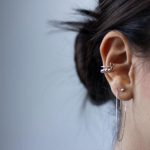
Hearing loss can come in different types, with different levels of severity and various characteristics. Different types of hearing loss required different treatments, and no two people have the exact same hearing loss condition. Let’s take a look at just how varied hearing loss can be.
Contents
Four Types of Hearing Loss
While most people note three different types of hearing loss, there are actually four different types — conductive, sensorineural, mixed, and auditory neuropathy spectrum disorder. The type of hearing loss primarily depends upon the manner in which hearing is impaired.
Conductive
Conductive hearing loss concerns the outer or middle ear. When you have this type of hearing loss, sound is being stopped from entering the inner ear due to obstructions such as fluid, earwax, or tumors in the outer or middle ear.
This type of hearing loss can in many cases be treated with medication (such as antibiotics) or surgery.
Sensorineural
This is the most common type of hearing loss. Sensorineural hearing loss concerns the inner ear and occurs when the inner ear nerves and hair cells are damaged. The pathways from your inner ear to your brain are impacted.
Common causes include the natural aging process, noise damage, or often a combination of the two. It generally can’t be cured or corrected medically or surgically. However, there are effective ways to overcome symptoms, including getting a well-fitted hearing aid.
Mixed
Mixed hearing loss includes both a conductive and a sensorineural hearing loss. When you have this type of hearing loss, there is an issue in the outer or middle ear and the inner ear or auditory nerve.
This might occur after a head injury, due to a long-term infection, or because of a disorder that runs in your family.
Auditory Neuropathy Spectrum Disorder
This lesser-known type of hearing loss occurs when sound enters the inner ear (the cochlea) without issue, but as the inner ear or the hearing nerve is damaged, sounds aren’t organized in a way that the brain can understand.
Auditory Neuropathy Spectrum disorder can affect people of all ages, from infancy to adulthood. If you have your hearing sensitivity tested and have auditory neuropathy, you may have normal hearing or hearing loss ranging from mild to severe and will likely have poor speech-perception abilities.
People with this type of hearing loss generally struggle to recognize speech more than a specialist would expect having seen their audiogram. A diagnosis of auditory neuropathy helps to make sense of why this is the case.
Degrees of Hearing Loss

Aside from the type, hearing loss can also come in different degrees of severity. If you go to an audiologist for a hearing test, you could be told that your hearing loss lies anywhere on a spectrum between mild and profound. Hearing loss is measured in decibels (dB), and is based on how loud sound needs to be for you to hear it (ie, inability to hear sounds lower than this dB number).
Normal hearing for example, is measured around -10 to 15 decibel hearing loss (dB HL) range by the American Speech-Language-Hearing Association (ASHA). This means sounds from the -10 to 15 dB range can be heard with no issue.
Mild
Mild hearing loss is categorized as between 26 to 40 dB HL.
A sound will have to be at a higher volume, 26 to 40 dB in order to be heard. If you have mild hearing loss, soft sounds will be hard to hear but you will generally hear most speech sounds.
Moderate
Moderate hearing loss is categorized as between 41 to 55 dB HL. If you have moderate hearing loss you’ll struggle to hear any speech if you’re having a conversation with someone at a normal level.
Moderately Severe
Moderately severe hearing loss is categorized as between 56 to 70 dB HL. People with moderately severe hearing loss can have trouble with conversations at noisy restaurants, vacuum cleaners, and even the sound of a shower!
Severe
Severe hearing loss is categorized as between 91 to 90 dB HL. If you have severe hearing loss, you will hear no speech when someone is speaking at a normal level, only some loud sounds.
Profound
Profound hearing loss is categorized as +91 dB HL. If you have profound hearing loss than you will certainly not be able to hear any speech, and only quite loud sounds. If you have profound hearing loss, the use of a hearing aid or other treatment is highly recommended.
High-Frequency Hearing Loss and Low-Frequency Hearing Loss

Another way to categorize hearing loss is by the certain frequencies you have trouble hearing. Depending on your hearing range, you can be categorized to have either high-frequency hearing loss or low-frequency hearing loss.
High-Frequency Hearing Loss
High-frequency hearing loss is a very common type of hearing loss. If you have it, you’ll find high-pitched sounds or frequencies between 2,000 and 8,000 Hz harder to hear.
Speech may sound muffled and you might find it hard to hear consonants spoken at a higher pitch (such as ‘s,’ ‘h’ or ‘f’). The high-pitched voices of women and children can also be hard to make out. You might feel like you can hear people, but not really understand what they are saying.
People of any age can have it but it often affects older people who have age-related hearing loss and have been exposed to long-term loud noise.
Low-Frequency Hearing Loss

If you have low-frequency hearing loss, you can’t hear deeper, low pitched sounds that occur in the lower end of the frequencies (2,000 Hz or lower). Some examples of low frequency sounds include waves and thunder.
Sometimes people don’t realize that they have low-frequency hearing loss for a while, as its relatively rare, and they can understand normal speech and take part in conversations (which usually signals healthy hearing).
However, talking in groups and noisy environments with background noise can alert you to your issues with low-frequency hearing loss if you struggle to hear in these scenarios.
Age, noise, genetic mutations, low cerebrospinal fluid pressure, Ramsay Hunt syndrome, diseases (such as Meniere’s disease), and viral infections can be causes of low-frequency hearing loss. A comprehensive hearing test will be able to identify your low-frequency hearing loss.
A hearing aid might be able to improve your ability to hear, as they can help amplify lower sounds (without over-amplifying higher-pitched sounds). It can take some time to find the best amplification for you and you might have to deal with recruitment (when some loud sounds are painful).
Other Hearing Loss Characteristics and Terms
Hearing loss can have different characteristics; here are some terms to describe them.
- Congenital or Acquired/Delayed Onset: Hearing loss can be present at birth (congenital) or show sometime later in life (acquired or delayed onset).
- Unilateral or Bilateral: Hearing loss is in one ear (unilateral) or both ears (bilateral).
- Pre-lingual or Post-lingual: Concerning when the hearing loss occurred – before learning speech (pre-lingual) or after post-lingual).
- Symmetrical or Asymmetrical: Concerning the extent of your hearing loss – the same in both ears (symmetrical) or different in each ear (asymmetrical).
- Progressive or Sudden: Hearing loss worsens over time (progressive) or occurs quickly (sudden).
- Fluctuating or Stable: Hearing loss can get better or worse over time (fluctuating) or can stay the same (stable).
- Noise Induced: Is your hearing loss the result of a sudden loud noise or prolonged exposure to loud noise?
As you can see, there are many different types of hearing loss, and each person’s symptoms are unique. If you think you might have hearing loss you should make an appointment with your doctor or audiologist.
The information in this guide has been written using the following reliable sources:
https://www.cdc.gov, https://www.nidcd.nih.gov, https://www.healthyhearing.com, https://www.verywellhealth.com, https://www.attune.com








